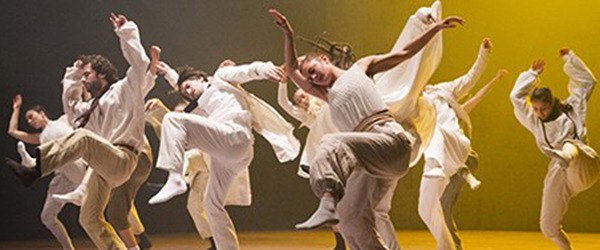Home | Blog | Sun & Score Part 1
Sun & Score Part 1
Image by Tristram Kenton
Who said winter is a time for hibernation?
Score was a much needed mini festival of dance, curated and presented by Performance Space at Carriageworks, especially considering the demise of Spring Dance at the Opera House. Within Score was Narelle Benjamin’s Hiding in Plain Sight, superbly executed by Kristina Chan and Sara Black.
I hadn’t read the program. The verbal instructions I was given in Gail Priest and Jane Mc Kernan’s work One Thing Follows Another earlier that evening still resonated with me. This was inspired by the post-modernist anti-art movement Fluxus, reducing movement to action without particular meaning or intent. My initial experience now framed the way I perceived Nellie’s. I was immersed in the exquisite vocabulary as two bodies moved like liquid pouring seamlessly over a smooth surface.
Narelle Benjamin’s Hiding in Plain Sight dealt with home, what it means and signifies. It was inspired by the writings of Romanian philosopher Mircea Eliade and by photographs of Francesca Woodman.
It was some time into the work that my intellect took over and I started to take note of the work in its entirety.
The set was sparse, consisting of a free standing door frame and two suspended window frames. The space was divided by a projected light source, consisting of a single white line, which formed an imaginary partition on either side of the door frame. Both dancers were allocated their own window. The movement began with them mirroring and then partnering, sitting on either side of the line at the threshold of their domains. Floor projections of differing textures were introduced, one a mangrove, the other textured wallpaper. Allocated space shifted and dancers encroached on each other’s terrain, leading me to imagine a Sliding Doors scenario where they (Sara and Kristina) were one and the same under different circumstances. I was also reminded of the many interactions I have experienced while in residence on remote indigenous communities, of elders who speak of ancestors who reside in specific trees, where other landmarks are named after them (the ancestors) and they are referred to in both the present and past tense. As Kristina Chan and Sara Black continued to skim the floor, moving with contorted dexterity, I was also reminded of more provincial ghosts and haunted houses.
Narelle Benjamin’s choreographic language, paired with her husband Huey’s meditative score, helped us enter a different realm.
Out of context I saw Sun, a performative interruption presented at the Opera House, choreographed by Hofesh Shechter, the much celebrated Israeli choreographer who is an associate artist of Sadlers Wells. The show began in darkness. Hofesh’s voice spoke to us in intimate yet sinister tones. He spoke of those among us who are hidden in plain sight.
Didn’t I just see that work? I thought. But no, this was where the similarity ended.
The lights came up and a glimpse of the finale was revealed. The lights went down, more sinister insight from Hofesh, followed by a spotlight on a cut out of a sheep propped centre stage.
This represented everything Jane’s work aimed to eschew. Whilst I couldn’t immediately work out who the heroes were, I soon got the point, as more sheep puppets, a wolf, some blackfellas (African?) and a colonialist were introduced, amongst the dancers, who were dressed as Pierrot clowns and assorted members of the nobility and serving classes. We too were counted amongst the villainous at one point, as the house lights were lifted and we were directly addressed as complicit perpetrators.
The movement was a virtuosic rendition of the folkloric and gestural, highly physical (aerobic), visceral and present. Shechter utilised balletic postures and phrases to symbolise colonial triumph, referring to a tangible past and present human condition. The action onstage was at times shambolic, with several strands of unison work occurring within a complex floor pattern that shifted almost as soon as the eye identified. His musical accompaniment was loud and equally chaotic, and much needed ear plugs weren’t dispensed until after opening night.
I wondered why he never alluded directly to the current situation of his people and realised that this would be a work that would not be seen. Not at the Opera House. Not without controversy and not without heavy security. Global sentiment has local ramifications.
Next week I will share the rest of the Score season including One Thing Follows Another, Antony Hamilton’s Keep Everything and Natalie Abbott’s Maximum.
– by Vicki Van Hout

